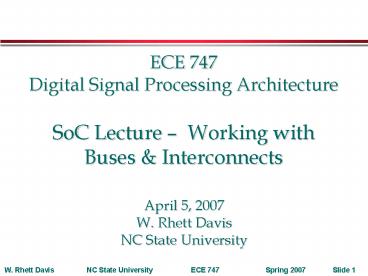ECE 747 Digital Signal Processing Architecture SoC Lecture - PowerPoint PPT Presentation
1 / 25
Title:
ECE 747 Digital Signal Processing Architecture SoC Lecture
Description:
Title: ECE 746 - VLSI Systems Design Lecture 23: Memory Author: Rhett Davis Last modified by: wdavis Created Date: 4/13/1997 2:24:48 PM Document presentation format – PowerPoint PPT presentation
Number of Views:155
Avg rating:3.0/5.0
Title: ECE 747 Digital Signal Processing Architecture SoC Lecture
1
ECE 747 Digital Signal Processing
ArchitectureSoC Lecture Working with Buses
Interconnects
April 5, 2007 W. Rhett Davis NC State University
2
Todays Lecture
- Introduction
- AMBA Peripheral Bus (APB)
- AMBA High-Performance Bus (AHB)
- AMBA Extensible Interconnect (AXI)
3
Why do we care?
- What is a Bus?
- What is an Interconnect?
- Why do we use them?
4
Our Question
- Which bus or interconnect should we use?The
answer depends on the following - What IP blocks do we have and what do they work
with? - How many ports do we need?
- What kind of overhead can we permit?
- Throughput
- Area
- Power
5
Bus Interconnect Standards
- AMBA from ARM
- Wishbone from OpenCores.org
- CoreConnect from IBM
- Sonics Silicon Backplane
- Well focus on AMBA in this class, because its
the one our simulator models.
6
AMBA Introduction
- Advanced Microcontroller Bus Architecture (AMBA),
created by ARM as an interface for their
microprocessors. - Easy to obtain documentation (free download) and
can be used without royalties. - Very common in commercial SoCs (e.g. Qualcomm
Multimedia Cellphone SoC) - AMBA 2.0 released in 1999, includes APB and AHB
- AMBA 3.0 released in 2003, includes AXI
7
AMBA 2.0 System-Level View
Source AMBA Specification, Rev. 2.0
8
Todays Lecture
- Introduction
- AMBA Peripheral Bus (APB)
- AMBA High-Performance Bus (AHB)
- AMBA Extensible Interconnect (AXI)
9
APB Introduction
- Low overhead only 4 control signals
- Only one master is allowed
- Three states IDLE, SETUP, and ENABLE
- Slave is non-responsive Transfer always takes 2
cycles - Makes timing easy to design data is always
latched between the two cycles
10
APB Read Transaction
- Transaction takes 2 cycles SETUP ENABLE
11
APB Write Transaction
12
APB Performance
- If AHB is high performance than APB must be
low performance. What does that mean? - If we were to connect an SDRAM as an APB slave
from the previous lecture, what would our minimum
bus clock period be?
13
Todays Lecture
- Introduction
- AMBA Peripheral Bus (APB)
- AMBA High-Performance Bus (AHB)
- AMBA Extensible Interconnect (AXI)
14
AHB Introduction
- Larger overhead 27 control signals
- Up to 15 masters allowed
- Split Transaction phases Address, Data
(Pipelined) - HREADY signal allows insertion of wait-states
15
AHB Architecture
- Central MUX is used, rather than a bus
- Achieves smaller delays than a single wire w/
tri-state buffers
Source AMBA Specification, Rev. 2.0
16
AHB Split-Transaction Bus
- Address preceeds data by one cycle
- Mimics SDRAM operation, achieves greater data
bandwidth
Source AMBA Specification, Rev. 2.0
17
Multiple Transactions w/ AHB
Source AMBA Specification, Rev. 2.0
- Addresses are pipelined to improve memory
efficiency - HREADY from slave allows insertion of wait states
18
AHB Burst Operation
- Bursts with lengths up to 32 are allowed
- What would happen if an incrementing burst read
to a DRAM row boundary?
19
AHB Access Grant Mechanism
- Bus arbitration takes extra cycles
Source AMBA Specification, Rev. 2.0
20
Todays Lecture
- Introduction
- AMBA Peripheral Bus (APB)
- AMBA High-Performance Bus (AHB)
- AMBA Extensible Interconnect (AXI)
21
AXI Introduction
- Larger overhead 77 control signals
- Up to 16 masters allowed
- 5 separate channels for address, data, and
responses - Not so much of an interconnect specification as a
protocol (interconnect architecture is left
unspecified)
22
Multi-Channel Support
- Address, Data, and Response split between
channels, rather than phases - Allows simultaneous reads and writes
Source AMBA AXI Protocol Specification
23
AXI Read Transactions
- Up to 16 transactions can be queued at once
24
Multi-Layer Connectivity
Source PL300Technical Reference Manual
- PL300 Interconnect is implemented as a crossbar
- Multiple masters can talk to multiple slaves
simultaneously
25
Comparison of AMBA Bus Types
APB AHB AXI / PL300
Processors all ARM7,9,10 ARM11
Control Signals 4 27 77
No. of Masters 1 1-15 1-16
No. of Slaves 1-15 1-15 1-16
InterconnectType Central MUX? Central MUX Crossbar w/ 5 channels
Phases Setup,Enable Bus request, Address, Data Address, Data, Response
Xact. Depth 1 2 16
Burst Lengths 1 1-32 1-16
Simultaneous Read Write no no yes































